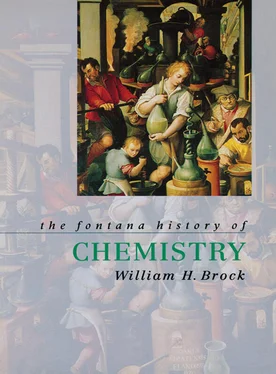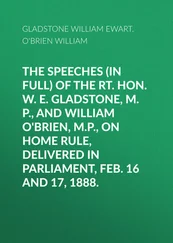Dalton thought differently. His long study of Newton’s Principia had made him familiar with Newton’s demonstration that Boyle’s law relating pressure and volume could be derived from a model in which homogeneous air particles were self-repulsive with a power inversely proportional to the distance. As a result of his meteorological studies, Dalton had become convinced by 1793 that water vapour could not possibly be chemically combined in air; instead, it was diffused among the other aerial particles and so freely available for precipitation or condensation as rain or dew. But if water was not chemically combined, why should the other constituents of air be?
If Newton’s model of the self-repulsion of air particles was translated into a model of self-repulsive constituents of air, what would be the consequences? Provided particles of one kind did not repel particles of a different gas, as Dalton showed, each gas or vapour would behave as if in a vacuum. The net effect would be a homogeneous mixture as the different gas particles repelled their own kinds. As to the cause of their self-repulsion, Lavoisier’s model of a gas supplied a satisfactory candidate: caloric. By imagining that the particles of oxygen, nitrogen, carbon dioxide and water vapour were surrounded by atmospheres of heat, Dalton arrived at a theory of mixed gases and, incidentally, a law of partial pressures that proved essential in quantitative work in gas analysis and barometry.
Dalton’s ‘New theory of the constitution of mixed aeriform fluids and particularly of the atmosphere’ was published in Nicholson’s Journal in 1801. It proved controversial, but this was no bad thing for Dalton’s British and European reputation. Most chemists who believed in the chemical theory of air wondered how it was that caloric atmospheres in different particles did not repel one another. Why suppose that there were ‘as many distinct kinds of repulsive powers, as of gases … and that heat was not the repulsive power in any one case’?
Dalton’s ingenious reply to this difficulty was published in full in the second part of the New System and was premised on differences of size of gaseous particles, the size being a function of both the atom’s volume and the radius of its atmosphere of heat. Using diagrams that look like the later magnetic force diagrams popularized by Faraday, Dalton showed visually that ‘no equilibrium can be established by particles of different sizes pressing against each other’. It followed that different particles would ‘ignore’ one another even when surrounded by the repulsive imponderable of heat. Such a static model remained the only satisfactory explanation of gaseous diffusion, partial pressures and atmospheric homogeneity until it was replaced in the 1850s by the kinetic theory of gases.
As historians of chemistry have shown, this second model of mixed gases, which was dependent on the sizes of atoms, was first developed by Dalton in September 1804, a full year after he had developed the first list of particle weights. The question of size offers a clue to his thinking during the previous year.
One of Dalton’s few supporters for the first theory of mixed gases was his Mancunian friend, William Henry (1774–1836), the owner of a chemical works for the manufacture of the pharmaceutical, milk of magnesia, used in the treatment of digestive complaints. Henry had at first opposed Dalton, only to be converted when he found that ‘water takes up the same volume of condensed gas as of a gas under ordinary pressure’. Henry’s law that the solubility of a gas at a given temperature depended upon pressure, which he discovered in 1803, was powerful evidence that solution was a purely mechanical effect. If chemical affinity was not involved, it seemed equally unlikely to be involved in the atmosphere. Moreover, as Henry found, a mixture of gases dissolved in water was ‘retained in its place by an atmosphere of no other gas but its own kind’.
Henry’s experiments were intriguing. Why, Dalton wondered, did different gases have different solubilities in water? Why were light and elementary gases such as hydrogen and oxygen least soluble, whereas heavier compound gases such as carbon dioxide were very soluble? If his first theory of mixed gases was correct, why should gases have different solubilities? Was solubility proportional to density and complexity? At this stage Dalton clearly thought solubilities were a function of the sizes of particles 3 :
I am nearly persuaded that the circumstance depends upon the weight and number of the ultimate particles of the several gases: those whose particles are lightest and single being least absorbable, and others more according as they increase in weight and complexity.
One can see how this line of reasoning would lead automatically to ‘an inquiry into the relative weights of the ultimate particles of bodies … a subject as far as I know, entirely new’. It is important to realize, however, that Dalton really needed to know the weights of particles only because he wanted an estimate of their sizes from the simple relationship, density = weight/volume.
As we have seen, at the end of 1803 Dalton estimated the weights of gas atoms using known chemical analyses and the rule of simplicity. From these he derived a number of atomic volumes and radii, but was unable to find any simple or regular correlation with solubility. Even so, as late as 1810 in the New System he continued to record atomic sizes alongside atomic weights.
It was evidently not until 1804 that Dalton realized that relative atomic weights were a useful explanation of the law of constant composition and that the simple rules of chemical synthesis from which he had derived them explained and predicted that, when elements combined to form more than one compound, the weights of one element that combined with a fixed weight of the other were bound to be small whole numbers. For example if
then the weights of A combined with weight B are in the simple ratio of 1:2. Dalton drew attention to the fact that this was the ratio of hydrogen to carbon in methane (CH 4) and ethane (C 2H 4), and that in the difficult and complicated cases of the oxides of nitrogen the ratio of oxygen to nitrogen was 1 : 2 and 1:3.
There were a large number of cases of this ‘law of multiple proportions’ that had been reported in the literature as a result of the dispute between Proust and Berthollet. When Berthollet accompanied Napoleon’s expedition to Egypt in 1798, he was surprised to find huge deposits of soda by the shores of salt lakes. Mineralogical analysis showed that the soda arose from a reaction between salt and limestone in the lake bottom, in complete contradiction to the usual laboratory reaction in which soda [sodium carbonate] and calcium chloride reacted to form salt and limestone [calcium carbonate]. He concluded that the enormous concentration of salt in the lakes had forced the reversal of the usual reaction. In other words, the action of mass (concentration) could overcome the usual play of elective affinities between substances. In modern terms, Berthollet had stumbled upon an equilibrium reaction:
CaCl 2+ Na 2CO 3  CaCO 3+ 2NaCl
CaCO 3+ 2NaCl
It was this awareness of the role of mass in reactions that caused Berthollet during the next few years to challenge the usual implicit presumption of chemists that substances combined together in fixed proportions, or that constant saturation proportions always characterized chemical union. Instead, Berthollet proposed that compounds combined together in variable and indefinite proportions, and he pointed to solutions and alloys, and what would today be defined as mixtures, as empirical evidence for his claim.
Читать дальше

 CaCO 3+ 2NaCl
CaCO 3+ 2NaCl










